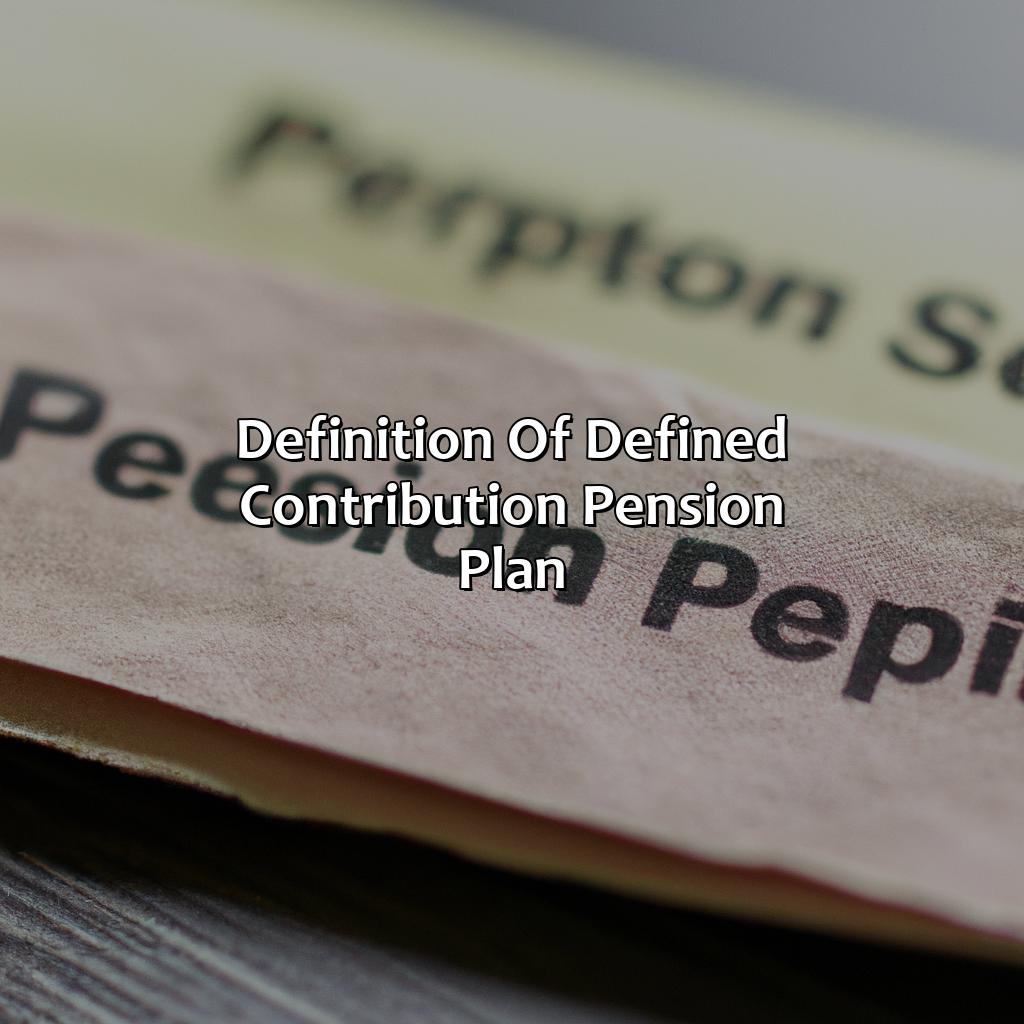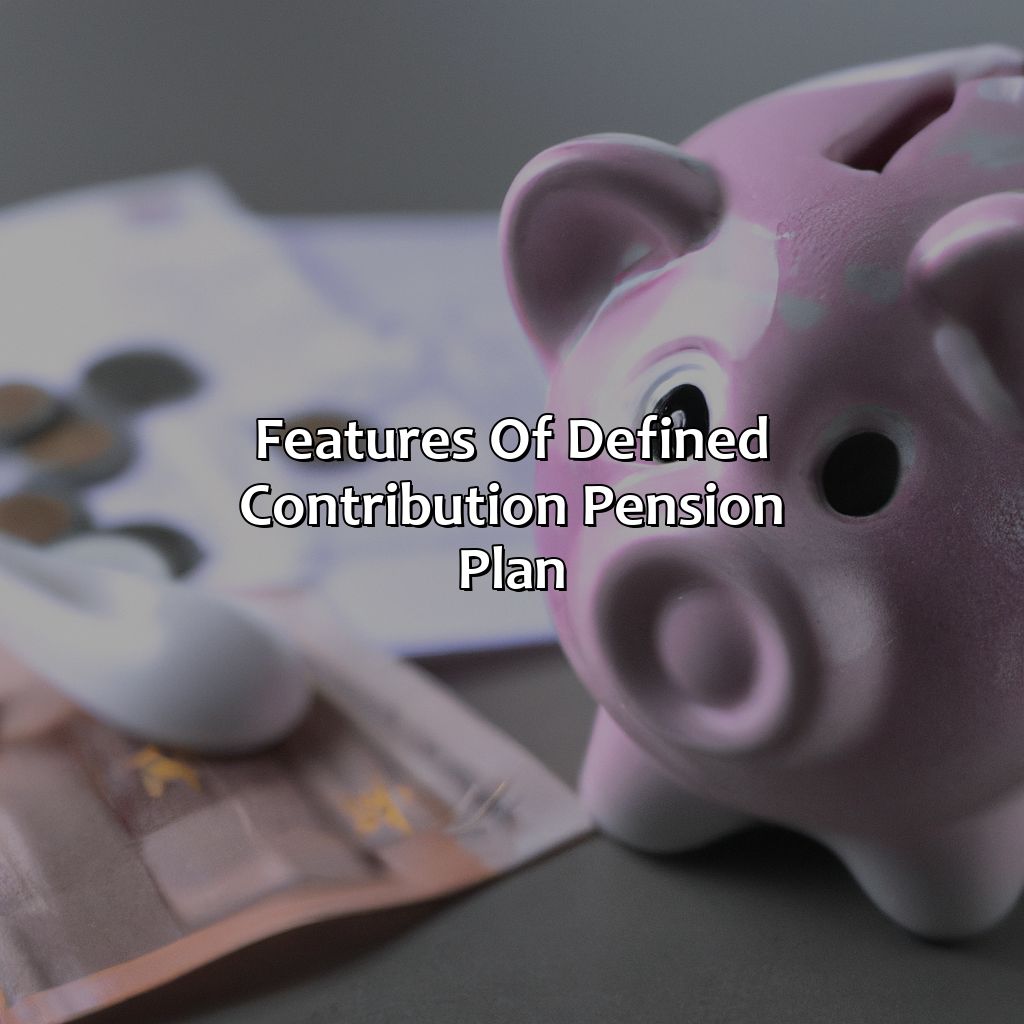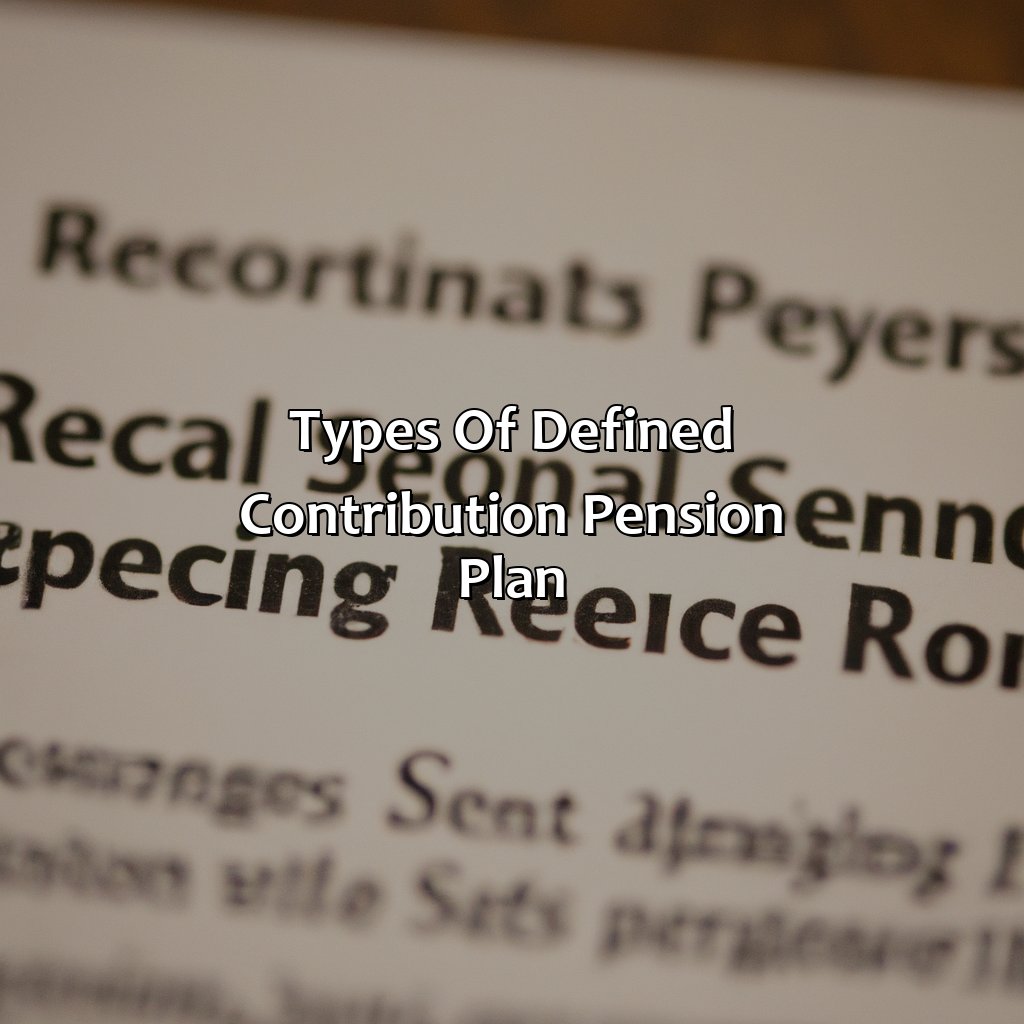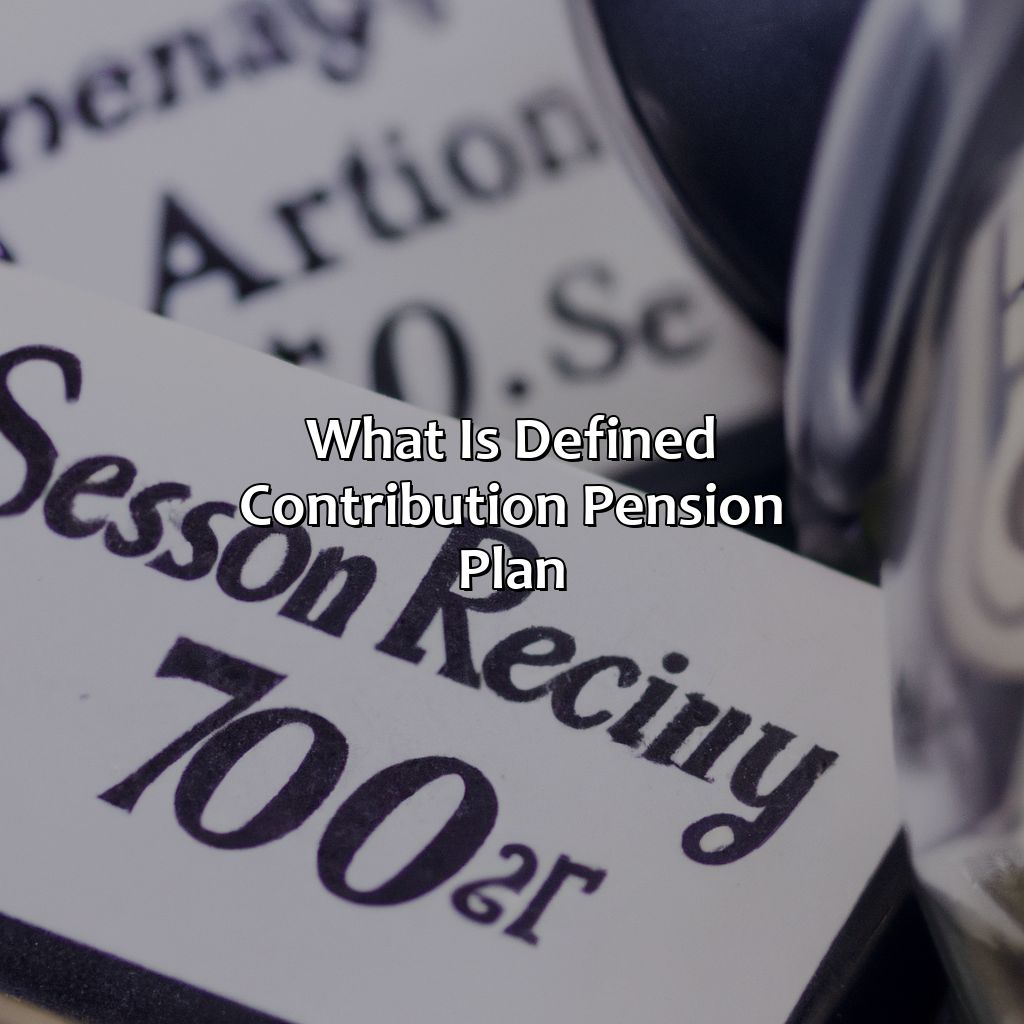What Is Defined Contribution Pension Plan?
Key Takeaway:
- A defined contribution pension plan is a retirement savings plan in which employees and their employers contribute a certain amount of money into an individual account for the employee. The eventual benefit is based on the total contributions and the performance of the investments within the account.
- The features of a defined contribution pension plan include contributions, investments, and benefits. Contributions are made by both the employee and employer and are often based on a percentage of the employee’s salary. Investments within the account are typically chosen by the employee from a selection of options provided by the plan. Benefits upon retirement are based on the total amount in the account at the time of retirement.
- There are three main types of defined contribution pension plans: 401(k) plans, Individual Retirement Accounts (IRAs), and Simplified Employee Pension (SEP) plans. 401(k) plans are sponsored by employers and allow employees to contribute a portion of their salary into a tax-advantaged account. IRAs are individual accounts that can be opened and contributed to by anyone, although there are income limits for tax-deductibility. SEP plans are also sponsored by employers and allow for larger contributions, but they may have limitations on who can participate.
Are you looking for new ways to save for retirement? A defined contribution pension plan is a powerful tool to help you reach your financial goals. You can save now and enjoy a secure future with this plan. Learn more about how this works and see if it fits your retirement plans.
Definition of Defined Contribution Pension Plan
A defined contribution pension plan is a retirement savings plan that allows employees to contribute a portion of their income into an individual account, typically matched by the employer. The plan maintains no promise of a specific retirement benefit. The retirement amount is determined by the amount contributed, investment performance, and fees. The responsibility of investment decisions lies with the employees. This type of pension plan has grown in popularity due to portability, transparency, and flexibility in contributions and withdrawals.
To maximize retirement savings, employees should contribute as much as possible and choose investments appropriate for their age, risk tolerance, and financial goals. Employers should offer competitive matching contributions, provide educational resources, and review fees regularly to ensure they are reasonable. Defined contribution plans should be monitored and adjusted as needed to meet retirement goals. Overall, a defined contribution pension plan provides employees with the tools needed to build a secure financial future.

Image credits: retiregenz.com by James Arnold
Features of Defined Contribution Pension Plan
To grasp the features of a defined contribution pension plan quickly, think of its sub-sections.
- Contributions to the plan come from employee and/or employer.
- Investments are made in multiple options.
- Benefits rely on investments’ performance and contributions made over time.

Image credits: retiregenz.com by Harry Duncun
Contributions
One of the focal points of a Defined Contribution Pension Plan is the financial contributions made by both employers and employees. Here are four important points to know:
- The amount contributed usually varies and is based on a percentage of an employee’s income.
- Employers may match a pre-determined portion or all contributions, making it crucial to understand their policy.
- A wide range of investment opportunities may be available to employees.
- Contributions made by employees are tax-deductible and investments grow tax-free until retirement age.
It is essential to note that contributions can vary from one DC plan to another, making it vital for each individual to read and understand their specific plan’s policy thoroughly.
Pro Tip: Set up regular contribution deductions from your paycheck, so you’re consistently saving towards your future retirement. Remember, investing in your future is a lot like avocado toast – if you don’t start early, you’ll end up paying way more for it later.
Investments
The retirement plan’s fund allocation is driven by the ‘specified contribution’ term; this brings out the variation called ‘Investment options.’ These options enable the employees to choose from a gamut of portfolio schemes offered by the plan. The said plans can either be stocks, bonds, or cash equivalents.
Moreover, investment option decisions have different levels of risk tolerance and potential returns based on market trends. In such pension funds, the employer matches a portion of employee investment amounts in their directed investments.
Furthermore, there are different investment structures offered like target-date funds where a combination of equity and debt shares’ holdings vary as per the target year of retirement. Other avenues include equities in emerging markets or conservative bonds that prioritize capital safety over growth.
If you are wondering what is a single life annuity pension, it is a type of defined contribution pension plan that provides a fixed payment to the annuitant for the rest of their life after retirement.
With a defined contribution pension plan, the only certainty is uncertainty – but at least you can take comfort in knowing your retirement savings are somewhat in your own hands.
Benefits
Defined Contribution Pension Plan – Gains and Advantages
A Defined Contribution Pension Plan is a type of retirement savings plan, which provides benefits that vary based on contributions made by employees and/or employers while employed. Here are some advantages of this plan:
- Flexibility: Participants have control over their investments and can choose from a range of investment options.
- Portability: Benefits under the plan are portable, which means that upon leaving employment, individuals can take accrued benefits or transfer them to another employer’s plan.
- Tax Benefits: Contributions are usually made pre-tax, reducing taxable income for participants. In addition, investment gains grow tax-free until withdrawals are taken.
- Retirement Income: Unlike defined benefit plans where employers bear the investment risk and promise a fixed monthly benefit at retirement, participants bear the investment risk in a defined contribution plan. However, they also potentially benefit from higher returns on investments.
It is noteworthy that unlike defined benefit pension plans, perquisites in defined contribution pension plans depend on the total amount of contributions made and investment choices selected.
If you’re interested in learning more about pension plans, you may want to check out the CAAT pension plan, which is one of the most popular pension plans in Canada.
Pro Tip: While selecting an investment option for this type of pension plan, consider one with diverse assets to spread risk across various markets. Learn more about what is a 501(C)(18)(D) pension plan and make informed decisions for your retirement.
Why settle for one type of defined contribution pension plan when you can have a smorgasbord of retirement options?
Types of Defined Contribution Pension Plan
Want to get to grips with the range of defined contribution pension plans? Check out this section on “Types of Defined Contribution Pension Plan”. It has three sub-sections – 401(k) Plan, Individual Retirement Account (IRA), and Simplified Employee Pension (SEP) Plan. With these solutions, you can give yourself and your employer a better financial future.

Image credits: retiregenz.com by Yuval Duncun
401(k) Plan
401(k) Plan is a kind of defined contribution pension plan that allows employees to save a part of their pre-tax salary for retirement. Here are 6 points explaining this plan:
- Employees can control the amount they save and choose investments
- Often includes employer matching contributions up to a certain percentage
- Withdrawals taken before the age of 59 may have penalties
- Can be rolled over into another qualified retirement account if employee leaves job
- Annual contribution limits apply and may change year to year
- Offers tax benefits, as contributions reduce taxable income.
401(k) Plans provide employees with greater control over their retirement savings and come with various benefits. However, it’s important to note that employers have different rules regarding contributions and withdrawals.
Investing in a DC pension plan can help individuals achieve their long-term financial goals. Don’t miss out on the opportunity to secure your future through smart saving. Start contributing today!
An IRA is like a hoodie in winter – it keeps your savings warm and snug.
Individual Retirement Account (IRA)
An Individual Retirement Account (IRA) is a defined contribution pension plan that enables individuals to save for their retirement. IRAs are one of the most popular retirement savings options available to US citizens. The contributions made by the individual and any earnings from investments within the IRA grow tax-deferred until withdrawn during retirement.
IRAs come in two primary types – Traditional IRA and Roth IRA. Participants of traditional IRA receive a tax deduction on their contributions, whereas those who contribute to Roth IRAs do not. Withdrawals from traditional IRAs are taxable in retirement whereas withdrawals from Roth IRAs are not taxable after age 59 provided certain conditions have been met.
\n
Do you know about the state second pension scheme? It is an additional pension you may be able to get if you reached state pension age before 6 April 2016 and you have earnings above a certain level. It is based on your National Insurance Contributions and is separate from your basic state pension.
IRAs also allow for catch-up contributions, which is an advantage for participants over 50 years old as they are allowed to contribute an additional amount annually to make up for lower contributions in the past. If you’re wondering what a money purchase pension plan is, it is essentially a type of defined contribution pension plan.
Not having sufficient money at retirement is a real fear among Americans. It’s crucial to start planning early and maximize your IRA contribution limit every year. Don’t wait until it’s too late start contributing today!
Simplified Employee Pension (SEP) Plan
A defined contribution pension plan where employers set up individual retirement accounts for their employees. Contributions are made solely by the employer and are tax-deductible. Employees can’t contribute. The plan allows employees to participate in establishing their own retirement fund.
In a Simplified Employee Pension (SEP) Plan, the employer makes contributions, not the employee. Employers have to make comparable contributions to all eligible employees including themselves. This plan is easy to set up and maintain with low administrative costs. If you are interested in learning more about retirement plans, you may also want to find out what is a pension sharing order.
SEPs have a higher limit than other kinds of defined contribution plans like traditional IRAs or 401(k)s, but only employers can add money into it, making it less flexible than other options. If you’re wondering how a pension is paid out, it depends on the type of pension plan you have. Defined contribution plans are paid out as a lump sum or periodic payments based on the amount contributed and the performance of the investments made with those contributions.
Pro Tip: Consider adding a superannuation pension scheme as an additional benefit for your employees to encourage loyalty and satisfaction within the workplace.
Five Facts About Defined Contribution Pension Plans:
- ✅ A defined contribution pension plan is a retirement savings plan where employees contribute a percentage of their salary and the employer may or may not match their contributions. (Source: Investopedia)
- ✅ The amount saved in a defined contribution pension plan is based on the performance of the investments selected by the employee. (Source: IRS)
- ✅ Unlike defined benefit pension plans, defined contribution pension plans do not guarantee a specific amount of payments in retirement. (Source: U.S. Department of Labor)
- ✅ Popular types of defined contribution pension plans include 401(k), 403(b), and 457 plans. (Source: Fidelity)
- ✅ With a defined contribution pension plan, employees have more control over their retirement savings and can make investment decisions based on their individual goals and risk tolerance. (Source: Charles Schwab)
FAQs about What Is Defined Contribution Pension Plan?
What is a defined contribution pension plan?
A defined contribution pension plan is a type of retirement plan where the employer and/or employee contribute a fixed amount of money to an individual account. The eventual retirement benefit is determined by the amount contributed and the investment income earned on those contributions.
How does a defined contribution pension plan work?
In a defined contribution pension plan, an employee and/or employer make contributions to a retirement account. The employer may match employee contributions up to a certain percentage or amount. The employee then has the option to invest the money in different investment options offered in the plan. The eventual retirement benefit is based on the total contributions made and the investment performance of those contributions.
What are the advantages of a defined contribution pension plan?
The advantages of a defined contribution pension plan include portable benefits, as the employee maintains control of the account even if they change jobs, and investment flexibility, as the employee can choose how to invest their contributions. Additionally, because the employee is responsible for investment decisions, there is no risk to the employer for investment performance.
What are the challenges of a defined contribution pension plan?
One challenge of a defined contribution pension plan is that it places investment risk on the employee rather than the employer. Additionally, because the retirement benefit is based on investment performance, there is no guarantee of a specific retirement income amount. Finally, because individual accounts are maintained, administrative costs can be higher than in a defined benefit pension plan.
Is a defined contribution pension plan the same as a 401(k) plan?
A defined contribution pension plan and a 401(k) plan are similar in that they both involve individual accounts where the retirement benefit is based on investment performance. However, a 401(k) plan is a type of defined contribution pension plan that is specifically authorized by the IRS, whereas a defined contribution pension plan can refer to any type of retirement plan where the benefit is based on employee and/or employer contributions.
Can I have both a defined contribution pension plan and a defined benefit pension plan?
Yes, it is possible to have both a defined contribution pension plan and a defined benefit pension plan. However, the contribution limits for each plan, as set by the IRS, apply to the total contributions from both plans.
